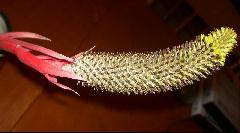
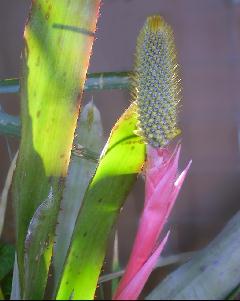
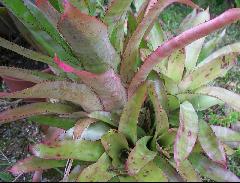
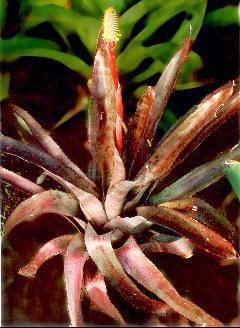
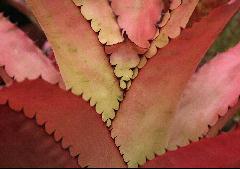
Aechmea ‘Minuta’ by Butcher Nov 2015.
Tania Wendt in Bot Journ. Linnean Soc. 125: 245-271. 1997 reviewed Aechmea pineliana and although not specifically treating Foster’s var. minuta with the type she did quote the size of Ae. pineliana as being from 25 cm to 100 cm high when in flower, and this would include this small form. Because this form is in cultivation, the name ‘Minuta’ will be conserved as a Cultivar in the Bromeliad Cultivar Register.
Protologue : Aechmea pineliana var. minuta M. B. Foster, Bromel. Soc. Bull. 11: 96, fig. 1961.
A var. pineliana omnibus partibus minoribus, seminibus paucis differt. Collected in Espirito Santo near Sta. Theresa, Brazil, in 1940 by M. B. Foster, #3052. Type in U. S. National Herbarium.
This new variety of Aechmea pineliana collected twenty years ago, in open forests, has been a favorite for many collectors ever since we brought it back alive to compare with the original Ae. pineliana var. pineliana which had been in our collection for several years. The typical variety came over from Europe with some of the earliest bromeliads introduced into the U. S. A.
The first time it was introduced into cultivation in Europe by Morel was about 1851. The first botanical description of it was published in Hortus Donatensis in 1854 when it received its first name, Echinostachys pineliana Brong. ex Planchon, possibly in honor of Dr. Pinel, consul in Rio de Janeiro at the time. Beer named it Echinostachys rosea in 1857, Lemaire called it Macrochordium pinelianum in 1862. Seventeen years later, in 1879, Baker placed it in the genus Aechmea where, ever since, it has rightfully remained under its present name.
The new variety, minuta, is much more attractive, both in color and form, than its prototype. Also, because of its miniature size it is more suitable as a house plant. Naturalized outside in Florida, it has stood a temperature as low as 25° F; it thrives best in good partially filtered light.